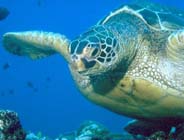Scientists fear beach restoration in Texas could hurt turtles' nesting season
Endangered Kemp's ridley sea turtles emerge here every spring from the Gulf of Mexico, leaving smeary trails of flipper prints from surf through sand to nests where they lay their eggs.

But a planned beach-restoration project could mean vehicles intruding on the nesting grounds, sand dumped over eggs or new sand obscuring the paths to turtles' nests.
The city is awaiting a decision from the Army Corps of Engineers on a variance from the Endangered Species Act that would allow the project to begin this month or next. Officials say the beach erosion caused by tides and last year's hurricanes is threatening property and needs to be repaired soon.
"Probably from a sea turtle standpoint, it's the worst two months of the year to do it," said Jeff George, curator of Sea Turtle Inc., South Padre's hospital for injured sea turtles and a partner with Fish & Wildlife in rescuing turtle eggs.
Jody Mays, a biologist for the U.S. Fish and Wildlife Service, and other turtle experts agreed May and June are the two worst months.
"But I don't want to be a tree hugger and say we can't do it," he said. "We can help put patrols out there and protect the nests. At the same token, you also have to say, why do you have to do it in May or June?"
If not alleviated soon, the erosion could harm hotels and other properties, said Catherine Ball, planner for the town of South Padre Island.
Ball said the town was prepared to provide some extra hands college students or volunteers to help find the turtle nests. Each year biologists collect and guard the eggs until late summer, when thousands of baby turtles scamper to sea. Without biologists' intervention, only a few would survive.
Without major disturbances, this year promises to be a good one for nest finds. At least 25 had been discovered on Texas beaches this past week, compared with five for the same period last year. By the end of April 26, the first day of the protection project, 10 nests had been found. The eggs will be monitored for the 48- to 62-day incubation period.
Once born, the turtles spend their lives at sea, with only females coming on shore again to nest on the beach where they were hatched.
The vast majority of Kemp's ridleys nest on a beach in the Mexican state of Tamaulipas, just south of Texas.
A home movie from 1947 shows about 40,000 nesting there. But the population has diminished dramatically because eggs were harvested for food or because shrimp trawls and gill nets trapped and drowned the turtles.
Beaches along South Padre and North Padre islands have been less-used nesting spots, and biologists hope their efforts to protect them will bring more females and create another major resting ground.
The beach on the north end of town, where South Padre's strip of hotels and high-rise condominiums peters out, has been eroding for many years, said Don Hockaday of the University of Texas-Pan American Coastal Studies Laboratory.
The town usually keeps on top of the problem by using spoils from dredgings of the ship channel leading to the Port of Brownsville, reports AP.
O.Ch.
Subscribe to Pravda.Ru Telegram channel, Facebook, RSS!


